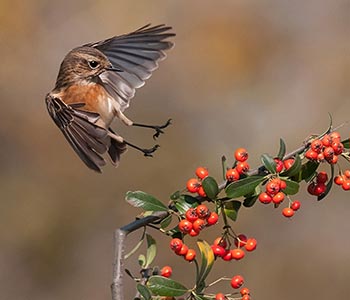
Bird feeding. What to bear in mind.
From 3 to 19 February, Gut Hardegg's big songbird count will take place again in cooperation with the Game Conservancy Germany and the British Wild Life Conservation Trust. An online bird training session was held in advance, here is a short extract on bird feeding. Everything else about bird identification and counting can be found in the → two-hour training in German language on Youtube.
January 2023
Quicktranslation with DeepL
More on nabu.de
Potocredits: Shimi eni
The adorable whinchat - here in a racing approach to rowan berries - is the Bird of the Year in Austria and Germany. Since 1998, the population of the formerly common dainty bird has declined by up to 80 percent, emblematic of many bird species. Due to cleared and intensively used landscapes, there is a lack of insects and plant food from shrubs, perennials and trees. For this reason, year-round bird feeding is strongly recommended. Here is a brief summary of what is important.
Feeding birds makes sense. On the one hand, it is of course primarily a matter of preserving the birds and satisfying their hunger. In winter, because nature provides too little and the energy demand is very high due to the low temperatures. In spring and summer, especially during the breeding season, when there is a naturally high demand for food. Due to monocultures, too much mowing and the use of herbicides and pesticides, there is a lack of seeds, grains, fruits, berries and insects. On the other hand, there is the wonderful side effect that bird watching makes people happy. And where better than at the bird house in your own garden or on the balcony.
Where to feed? It is best to place feeders in a place that is safe from cats and birds of prey: on a branch that is not too thick on a bush, in a tree or on a high post. If on the balcony, please keep away from large windows so that no bird flies at the window pane, ideally always near a garden, park or orchard. The more natural habitat there is, the more birds will come to the feeding station. If you do not have the opportunity yourself, you can also set up feeding stations at the edge of the forest, often forest managers even specifically ask for this. A combination of different feeding stations would be ideal, preferably filled with different types of food: grains and seeds, fat food, corn on the cob, nuts, apples, mealworms, ... See also the Nabu winter food board (in German, but self-explanatory as far as it goes). If you have enough space in your garden, it also makes sense to feed on the ground. Some birds, such as yellowhammers, wrens, chaffinches and larks, feed mainly on the ground. There are troughs or feeding buckets for this purpose. You can also build a small platform under the feeder on which the falling food collects (and is protected from rodents by the elevation).
And then it takes patience. It can take up to a year for word to get around among the birds about the new food source and for them to become accustomed to it. Therefore, the bird house should be filled all year round and started long before the onset of winter. It is important that there is always food in the bird house or silo, because even a single day without food can be fatal in winter.
Hygiene is important. As always, where many of a species meet, diseases can spread. Feeding areas should therefore be cleaned regularly with hot water and droppings should be removed immediately. Feeding silos with attached perches (sticks, rings, ...) or silo houses or feeders with slipping feed are better than those where the birds land on the grains. Old and possibly mouldy feed should also be disposed of. Feed that falls on the ground can attract mice and, in urban areas, rats. So it is better to remove it.
What to feed? Not all bird food is the same. As with our diet, regional food is better because the birds are used to it. And regionally grown food is better because cheap imported food is often of poor quality and contaminated with pollutants. Leftover food and bread should be taboo, but apple cores are allowed.
-
Basic feed: Many birds are omnivores, most like small and large seeds and grains, nuts and cereals. Good groundbait consists of four components:
- Loose feed with a high proportion of sunflower seeds, hemp, a little grain and a good amount of peanuts.
- Fat feed with oat and wheat flakes
- Tit dumplings or similarly shaped fat (preferably from beef tallow), preferably in silos or fat bells, which you can easily make yourself from flower pots. Caution: Birds can get caught in nets.
- epossibly pieces of apple (for blackbirds, green woodpeckers, juniper thrushes).
-
Optimal supplementary feed:
- Peanut fragments and chopped nuts. Provide these in dispensers, otherwise squirrels and crows will be attracted.
- Sunflower seeds shelled. Some birds eat too hastily and do not bring up the kernels. The added benefit, there is no shell manure on the ground.
- Thistle and lettuce seeds, poppy seeds and other small seeds for goldfinches, linnets and larks. Or for simplicity, canary food.
- Soft food like dried mealworms and insects and soya flakes for thrushes and the sweet wren.
What about water? In dry summers, watering places are essential for birds to survive, but birds are also thirsty in winter - especially when there is a lack of snow and rain. They come to watering places both to refresh themselves and to bathe. The cold cannot harm them because of their water-repellent plumage. Shallow bowls, such as clay saucers for flower pots, possibly with stones to sit on, are suitable drinking vessels. Regular cleaning is also important here.
Last but not least. Since there is an increasing lack of natural nesting sites, nesting boxes should be placed in trees and well protected places. Bird lovers are very likely to be rewarded with young birds. And then it makes your heart smile!




